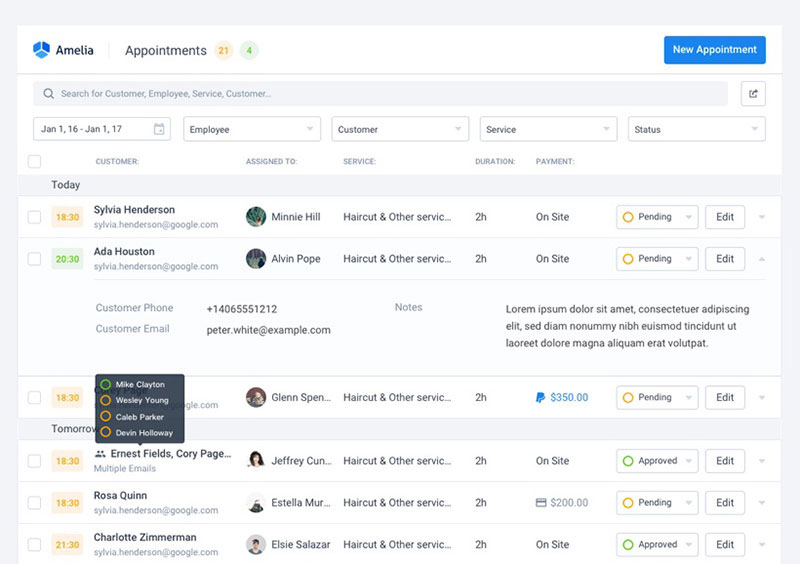Service businesses already rely heavily on giving quality service to clients, and quality service depends greatly on the satisfaction and performance of workers. This means that effective shift management can be a deciding factor in the profitability and success of your service business.
When managing a business in the service industry, you need to consider the needs of both your employees and your clients, especially when creating work schedules.
This can easily mean spending hours assigning shift schedules to the right employees and attending to employees who swap shifts.
To help you improve the effectiveness of your shift schedule management, this article will discuss the challenges, benefits, and best practices of shift management. It’ll also give you some useful tips, tricks, and insights that can help improve your scheduling and communication.
Let’s dive in!
What Is Shift Management?

Image by pch.vector on Freepik
Although shift management may sound complicated and involved, it actually just refers to shift planning. That is to say, identifying and organizing the tasks that need to be done over a certain period. This could mean organizing teams and deadlines for certain projects, or it could refer to planning projects as a whole.
Shift management is absolutely necessary for any business that uses multiple working shifts. This can especially be true for service businesses that offer 24/7 customer service because poor management can result in some employees being overworked while others aren’t working enough.
The main purpose of shift management is to improve employee efficiency.
This is done by choosing a work shift type that works for your business, as well as by balancing employees’ work schedules with your business needs.
This requires you to consider factors like employees’ qualifications, skills, availability, and labor laws in your region.
You can think of it as one big moving puzzle. There is a solution, but that solution will move and change from day to day.
Benefits of Shift Management
Shift management deals with probabilities. The better your shift management system, the smaller the chance of something going wrong. Properly aligning and managing schedules is a crucial task, although a time-consuming one. But the truth is, it helps.
How else can shift management help? There are many other benefits of effective shift management. The following is a short list of the benefits.
Enhanced workforce productivity
Good shift management involves assigning shifts to the most eligible employees. This helps maximize your employees’ productivity and reduce the chance of over or understaffing. When all is said and done, this leads to more efficient operations and overall improved performance for your business.
Compliance with labor laws
To fully optimize your shift management, you will need to learn your area’s labor regulations and employment laws.
This includes researching your area’s maximum working hours, breaks, rest periods, and implementing the proper shift management practices to comply.
Following the labor laws prevents any legal risks and possible penalties involved with labor law violations.
Better customer service
When you properly manage your shifts, you can better ensure that you have enough staff during your peak time slots, therefore ensuring quick and thorough service for your clients.
By employing the right employees at the right times, you can reduce waiting times, improve your customers’ experiences, and better handle customer inquiries and requests.
Improved employee satisfaction and engagement
Taking into account things like employee availability, preferences, and work-life balance is bound to increase your employees’ job satisfaction.
When employees are happy it leads to higher employee engagement and better service for your customers.
Whenever your employees have more control over their schedules and are able to better balance their professional and personal commitments, they are often more productive, motivated, and loyal to your business.
Cost optimization
Effective shift management helps lower your labor costs by eliminating unnecessary overtime expenses and lowering overstaffing mishaps.
If you can optimize your resource allocation by changing staffing levels depending on demand levels, you can greatly reduce your labor costs without losing service quality.
More effective responses to unexpected events
Since projects rarely run smoothly unforeseen setbacks are guaranteed, especially when it comes to long-term projects.
By optimizing your schedule management, you can plan for these setbacks by bouncing back the dates, resources, or scope of the project.
When you are well prepared, you can deal with these pop-up problems both serenely and effectively without pushing your project back.
Challenges Behind Schedule Management

Image by vectorjuice on Freepik
Sadly, effective schedule management does not come without its difficulties. It isn’t easy. It takes time and requires a lot of effort. Is it worth the work needed?
The only way to find out is to compare the challenges to the benefits. The following are some of the key challenges involved in schedule management.
Sub-optimal resource allocation
Nothing is free; that’s one of the first rules of business. When doing business, every task needs resources to be completed.
This could mean spending varying amounts of time, money, materials, or personnel on tasks of varying complexity and urgency.
Schedule management takes time and, depending on the size of your company, sometimes requires the attention of a full-time employee.
Different types of work shifts
Often service businesses need to use a wide range of work shifts to fully accommodate their customers’ needs. These shift types can range from day shifts, night shifts, rotating shifts, split shifts, or on-call shifts.
All of these shifts work very differently and need their own group of shift workers. Some have to deal with employee fatigue. Others need to ensure a proper handover between shifts.
All employers need to maintain a consistent level of service quality. Trying to balance your employee’s availability and preferences within all of these shift types can prove to be a difficult and intricate task.
The difficulty of shift planning
Good shift management involves placing your employees in specific shifts that ensure optimal productivity, coverage, and customer service.
This is a great tool for businesses, but it doesn’t come easily. In fact, a planned schedule can easily require changes depending on fluctuating employee skill sets, labor regulations, demand, and time-off requests.
There is also always the chance of unexpected absences or random events that can require real-time adjustments to your schedule, further complicating the planning process.
No mechanism for feedback
Last of all, set schedules often have difficulty creating the proper mechanisms for regular feedback. This is a harsh blow because a lack of feedback can lead to problems like miscommunication, dissatisfaction, and errors.
How Can You Plan Shift Management Effectively?
Now that you have seen both the benefits and challenges of schedule management, are you ready to say whether it’s worth it or not? It is probably still too early to tell because many of the challenges involved with shift management can be overcome through the use of various tools and strategies.
Understand business demand
Analyze historical data to understand your business’s peak hours and days. Schedule more staff during busy times and fewer during slower periods to match demand.
Consider employee preferences
Whenever possible, take into account employee preferences for shift times and days off. Happy and satisfied employees are more likely to be productive and stay with your company.
Also, encourage employees to provide feedback on shift schedules and their workload. Use their input to make adjustments and create a more balanced and productive work environment.
Cross-train employees
Cross-training employees in various roles can help you respond more flexibly to unexpected staffing issues. Have a contingency plan for unexpected staff shortages due to illness or other emergencies. Cross-train employees to step in when needed, or have a list of on-call staff who can fill in on short notice.
Cross0training also ensures that employees gain a broader skill set.
Streamline communication and collaboration
There are many shift management tools and employee scheduling software that can help facilitate better communication between you and your employees.
Through a shift management tool, you can share schedules, updates, and shift changes in real time to avoid any confusion or miscommunications.
Just make sure that you enable employees to request time off or shift changes through the scheduling tools themselves to streamline the process.
Utilize scheduling tools and plugins for efficient management

As a service business owner, relying only on a shift management tool is not enough. It simply won’t cut it, as you need a solution designed to cater to both shift scheduling and appointment scheduling.
With the right tool, you’ll not only be able to organize employees’ work, shifts, and information, but you’ll also be on top of your appointment scheduling and customer management as well.
Luckily for you, such a tool does exist and its name is Amelia.
Manage your shifts and appointments with Amelia
You know what’s exhausting? Managing appointments, employee schedules, events – oh, and let’s not forget the endless stream of customer interactions. It can quickly turn into a madhouse!
But guess what, there is a solution: Amelia. Yup, this is a solution every service business owner has been searching for.
Goodbye stress, hello smooth operations
Amelia is smooth sailing all the way.
- Automating appointments? Check.
- Streamlining events? Check.
- Seamless communications? Check
- Employee shift and schedule management? Big fat check!
No more juggling around. Amelia is like having your personal assistant, who doesn’t take breaks. Ever. It’s got your back 24/7!
Skyrocket your efficiency
Don’t even get us started on the time-saving part. You know those hours wasted in back-and-forths and miscommunications?
Kiss them goodbye.
Amelia’s user-friendly interface makes appointment booking a piece of cake. Customers can book, cancel, or reschedule appointments on their own.
And the best part?
Zero errors!
Stay in the loop
This plugin doesn’t just work hard; it works smart! You get to customize notifications and reminders.
So no more forgotten appointments or double-bookings. Trust us, your customers will appreciate it.
Analyze like a pro
Also, the analytical tools? Absolutely brilliant! Data is no longer just a bunch of numbers.
Amelia makes sense of it all – customer preferences, peak times, employee performance – you name it! Make informed decisions and watch your business thrive.
Cater to the crowd
Remember that one time when you had to turn down customers because you were fully booked? Not anymore.
Amelia smartly distributes workload among your staff. So, everyone’s happy – your team, your customers, and especially, you!
Sounds great, right? But don’t just take our word for it.
Give Amelia a spin and see the magic unfold. Because in business, it’s all about working smarter, not harder. And Amelia is the smartest tool in the shed.
Define shift policies and guidelines
If you’re still worried about appointment scheduling mistakes or double bookings, try establishing clear shift policies.
This would include setting specific rules for things like breaks, shift rotations, time-off requests, and shift coverage. By communicating these guidelines to your employees, you can rest easy knowing that everyone will be on the same page.
Regularly evaluate and adjust
By continuously monitoring your strategies’ effectiveness and making the necessary adjustments, you can eliminate one of the biggest issues of set schedules – the lack of feedback.
Keep records of employee hours worked, labor costs, and customer traffic patterns. Analyze this data to identify trends and make informed decisions about staffing levels and scheduling.
By making efforts to improve known to both your employees and customers, you can encourage feedback and build pathways to improve.
FAQ on Shift Management in the Service Business Sector
What is shift management?
Shift management is like a game of chess in the service sector. It’s about planning who works when, to make sure you’ve got the right people on deck at the right times.
It covers scheduling, tracking time, managing replacements or swaps, and keeping everything fair and legal. It’s a crucial part of running a smooth operation.
Why is shift management important in the service sector?
Think of shift management as the oil that keeps your service business engine running. It ensures adequate staff coverage during business hours, reduces the risk of overstaffing or understaffing, helps maintain employee satisfaction, and ultimately improves customer service.
Without effective shift management, your business may face some serious speed bumps.
How can technology help with shift management?
Tech comes to the rescue in shift management like a superhero! Modern shift management software, along with dedicated resource management software, automates scheduling, time tracking, and even communication between employees and managers.
It’s about saving time, reducing errors, and making life easier for everyone. With time tracking tools and virtual assistance, managing hours and the rota becomes effortless.
What should I consider when creating shift schedules?
When arranging the chess pieces of your shift schedule, consider your business needs (busy times, coverage), legal requirements (overtime, breaks), and your employees’ needs (availability, fairness). Balance is key.
You want a schedule that serves your business, respects your team, and keeps everything ticking over nicely.
How can I handle shift changes or swaps effectively?
In the shift swap dance, clear communication and fairness are key. Software can help by providing a platform for requests and approvals.
Always keep track of changes to avoid confusion or disputes, and have a clear policy in place so everyone knows the steps.
How can shift management improve customer service?
With effective shift management, your team is always ready to serve. You avoid understaffing that can lead to long waits or poor service.
Happy, well-rested employees are likely to provide better customer service, too. It’s a win-win.
Can shift management impact employee satisfaction?
Absolutely! Fair, predictable shift schedules can improve work-life balance and job satisfaction. Nobody wants to feel like they’re always closing or never get a weekend.
Well-managed shift changes and swaps also help. It’s about showing your team you value their time and well-being.
What challenges might I face in shift management?
You might face scheduling conflicts, last-minute changes, or disputes over shifts. Legal compliance can also be a challenge.
It’s like navigating a maze, but with the right tools and approach, you can do it. And remember, challenges are just opportunities in disguise!
How can I ensure legal compliance in shift management?
Knowledge and vigilance are your tools here. Be aware of the legal requirements regarding work hours, overtime, and breaks in your area.
Use technology to track hours accurately and prevent violations. When in doubt, ask. It’s better to be safe than sorry.
How do I choose the right shift management software?
Choosing the right software is like finding the perfect pair of shoes. Consider your needs (size, features, integration), budget, and the vendor’s reputation.
Do they offer support? Can you try before you buy? Remember, the right software should feel like a perfect fit for your business.
Is Shift Management Really Important?
By now you no doubt understand how important optimizing your schedule management is to your business. It improves your business’ performance and lets your staff work on projects that interest and motivate them. It improves client satisfaction and decreases wait times.
A well-planned and efficient shift management system is necessary for smooth operations in every service business (or every business in general, for that matter). If employees don’t know what they’re supposed to be doing, they won’t be able to do their job. If employees can’t do their job, then clients can’t enjoy their services. Everyone loses.
It may still seem like a daunting task, but by using the strategies listed in this article and implementing Amelia and its scheduling hacks into your business, you will no doubt be able to optimize your shift management to the max. All that’s left is to get started.
Happy scheduling!
If you enjoyed reading this article about shift management, you should read these as well:
- Why is Time Management Important and How to Get More Done
- How to Effectively Schedule Appointments: Tips & Tricks
- Small business management software you should check out

